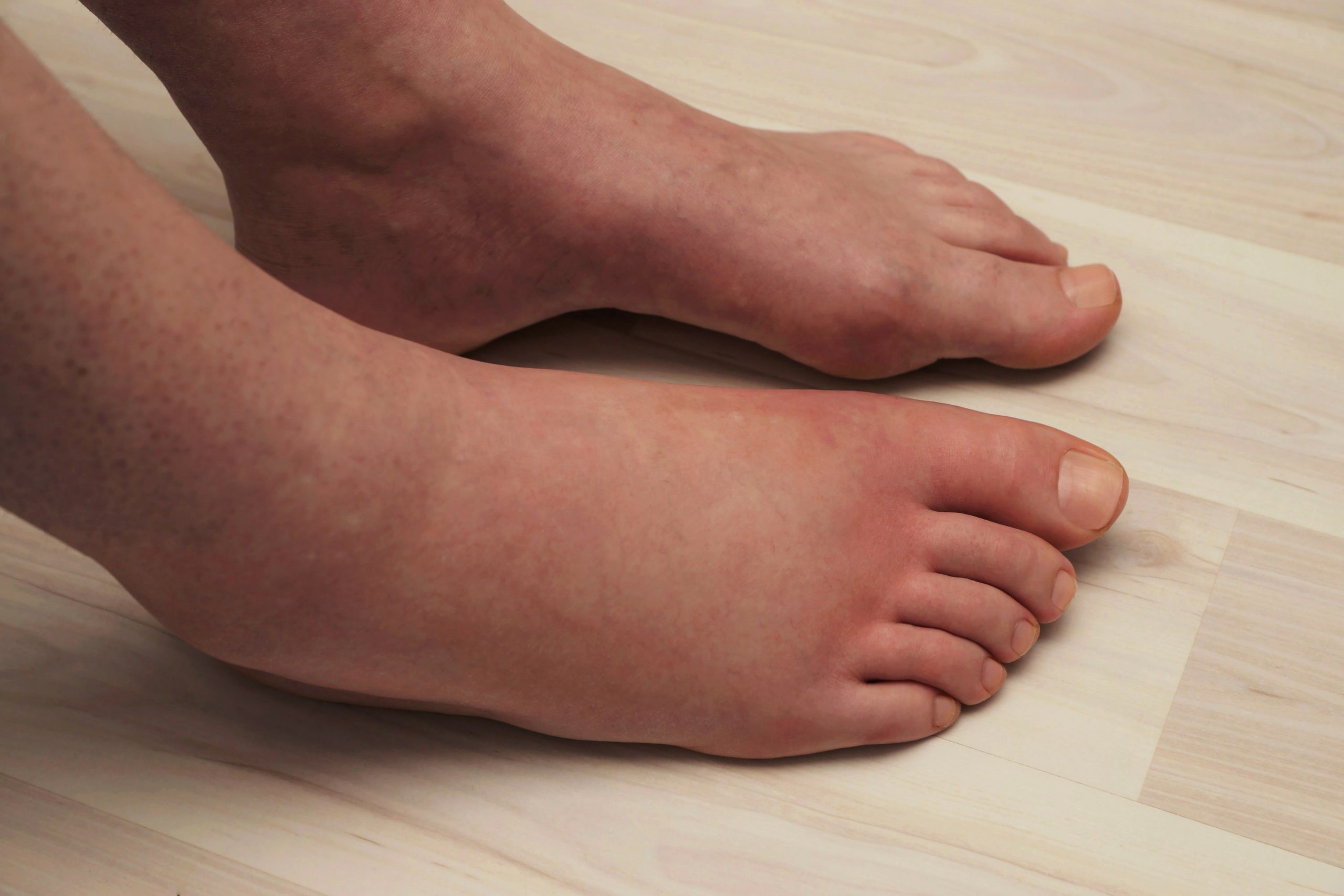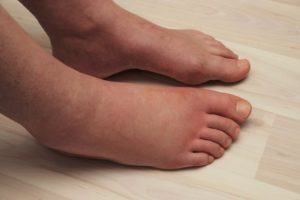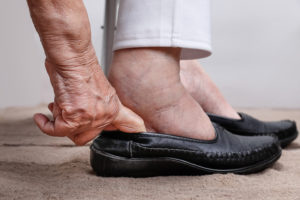
 While swollen feet are a common problem we see here at My FootDr, it is also quite concerning for many patients – and frustrating when the only shoes you can fit are those ratty sandals you should have thrown out years ago.
While swollen feet are a common problem we see here at My FootDr, it is also quite concerning for many patients – and frustrating when the only shoes you can fit are those ratty sandals you should have thrown out years ago.
Alongside the swelling, you’ll likely also be feeling discomfort or tenderness when walking or standing, and your skin may appear discoloured and tight. While foot and ankle swelling is most common in pregnant women and the elderly, it affects young adults too, and may even be a sign of an underlying problem that needs further investigation to rule out serious causes.
Let’s get into some of the reasons why your body is retaining too much water in your lower limbs and causing swelling, and what you can do to help.
Pregnancy
Your blood volume increases anywhere between 20-100% during pregnancy, your uterus grows approximately 500 times its original size by the time you reach full-term, and the hormones in your system cause greater laxity in the ligaments and supporting structures in your feet and body. There’s a lot working against you, preventing the efficient circulation and the return of blood to your heart – including gravity.
What will help: Compression stockings are often found to be very helpful by pregnant women to manage or reduce their swelling. Elevate your feet and legs about the level of your hips (or heart if you’re happy lying down) to allow the blood to return easier, and drink plenty of water to help promote healthy kidney function.
Injuries: Strains, Sprains, Breaks, and Infections
Anytime you have a new injury, your body naturally initiates an inflammatory response in the area, sending more blood (which carries the infection-fighting and reparative cells) to the area to kickstart your recovery. This swelling will tend to be localised and accompanied by pain and potential redness, warmth and bruising.
If you’ve developed an infection, your body also sends more resources to the area to actively fight the infection, and swelling results.
What will help: Unlike generalised fluid retention—you’ll want to stay off that swollen foot. Rest, ice, elevating the foot and booking an appointment with your podiatrist is the best way forward in this case. If you have an infection, consult your doctor to see if you require antibiotics to best manage the infection.
Vein problems
While your arteries transport blood from your pumping heart to the rest of your body including your feet and legs, it is your veins that are responsible for returning the blood back to the heart. As we age, or our veins are placed under strain, the veins become damaged and don’t perform their job quite as well – resulting in excess fluid being left in the feet and ankles. This is called venous insufficiency, and you may also notice some purple-blue spider veins or varicose veins pop up on your legs too.
Medical conditions & disease
 Whether they affect the feet and ankles directly or are primarily present elsewhere in the body, there are a number of conditions and diseases that can result in swelling at the feet, ankles and the lower leg. Inflammatory joint conditions like rheumatoid arthritis are a common example, as are liver, heart and lung problems among others.
Whether they affect the feet and ankles directly or are primarily present elsewhere in the body, there are a number of conditions and diseases that can result in swelling at the feet, ankles and the lower leg. Inflammatory joint conditions like rheumatoid arthritis are a common example, as are liver, heart and lung problems among others.
What will help: Getting straight to the underlying problem is the best treatment here. That means addressing your arthritis flare-up, or seeking help for your heart problems with your doctor or cardiologist.
Medications
Our bodies are like machines that need to be carefully calibrated. When we start new medications, or increase the dose of our current medications, this balance and our body processes and hormones can be thrown off, and the outcome can create swelling in the feet or legs. Birth control, steroids, and treatments for nerve pain and diabetes are common culprits of swollen toes, as are systemic medications used to manage chronic problems.
What will help: Talking with your doctor or whoever prescribed the medication about the swelling you’re experiencing as a side-effect, and if there are any alternatives that may reduce and manage your swelling.
Blood Clots in Your Legs
This one is much less common, but potentially much more serious. The danger of a blood clot is that it prevents fluid from travelling efficiently through your vessels around your body by clogging the path.
There are two types of blood clots: superficial and deep. Superficial clots result in redness along with swelling that hurts when pressure is applied—this can occur anywhere in the body where clots form. Deep vein thrombosis (DVT), the more serious condition, will result in swollen feet and ankles if it occurs anywhere along the legs. This will typically affect only one leg.
What will help: If you suspect your swollen foot is the result of a blood clot, call your doctor and seek help immediately. Do not massage the area – it may cause the clot to break off and travel to another part of the body, like the heart, lungs or brain.
Diet & Lifestyle
With two in three Australian adults not maintaining a healthy weight, diet and lifestyle may also be the cause of your swelling. In this case, fluids build up where it’s not supposed to for a variety of reasons. We’re mostly made of water, so if our bodies think our resources are dwindling, we’ll hold onto it. And if the flow of liquid (think blood or lymphatic fluids) becomes blocked, it gathers.
Gravity paired with increased body weight can make it difficult for our system to move blood away from our feet. Fat deposits can also restrict our bodily fluid flow. Excessive salt (like we find in fast foods, junk foods, and packaged foods) dehydrates the body, causing water retention. In addition, a sedentary lifestyle involving sitting or lying for long periods discourages blood and lymphatic flow.
What will help: Making diet and lifestyle changes. Eating less salt, drinking more water, getting regular exercise and reducing fat and sugar intake can all help – here it’s best to consult your nutritionist or GP to help you optimise these changes and stay on track.
Lymphoedema
Lymphedema affects 300,000 Australians at any given time. It occurs when the lymphatic system (the bodily processes that govern fluid use) is damaged. Damage often comes from events such as surgery, injury, or treatments like radiation.
If the swelling in your feet is due to lymphoedema, you might experience:
- Feelings of heat and heaviness in your feet and/or arms
- Pins and needles or tingling sensations in your skin
- Flashes of pain that come and go
What will help: Compression stockings and visiting your podiatrist who can help you manage any associated discomfort, problems with walking, and pain with your lymphedema.
Swollen Feet and Ankles: Is it Serious?
The causes of swollen feet and ankles can vary greatly, For some their swelling is temporary and may quickly pass, for others it’s an indication of an underlying problem or disease that needs to be promptly addressed.
If you’re concerned about the swelling in your feet, legs or ankles, our experienced podiatry team are here to help. My FootDr has clinics around Australia dedicated to helping you stay healthy on your feet, so you can lead your best life. Book your appointment online by clicking here or call us on 1800 FOOT DR.


